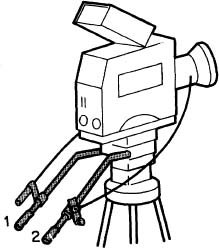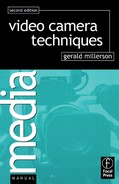There are three features of your camera lens that you need to know about to use it effectively:
• How its focal length affects the picture and the camera’s handling.
• The way focusing can influence the audience’s concentration.
• What happens when you adjust the lens aperture (iris; f-stop).
We shall be discussing the practical aspects of these features in detail later. For the moment, let’s take a look at the way you make these adjustments.
Most video cameras are fitted with a zoom lens. As you have probably discovered, this provides a variable coverage; from a wide-angle setting, that takes in a large area of the scene, to a narrow-angle or telephoto setting showing a much closer, more restricted view.
The ‘zoom’ effect is achieved by adjusting certain elements within the lens barrel. Repositioning these alters the lens’ effective focal length. When zoomed right in to the telephoto setting, the focal length is at its longest. Zoomed right out to the wide angle position, the focal length is shortest.
You control zooming manually by turning a knob on the lens barrel, or a hand control on a pan-bar (panning handle). (The latter may be a direct cable or servo-motor controlled). On many cameras, a two-way rocker switch on the right side of the lens assembly, controls a motor which drives the zoom in and out. The power zoom speed varies with the switch pressure.
To focus the subject, either the entire lens system is moved in/out, or internal lens elements are repositioned while the lens-to-light sensor (CCD) distance remains constant. The simplest method of focusing, is to rotate a ring on the lens barrel, where a scale shows the focused distance. Alternatively, a remote focus control on a pan-bar may be used to adjust focus, or a focus knob fixed at the side of the camera.
Looking inside the lens barrel, you will see a multi-bladed diaphragm or iris. This adjusts the lens aperture, and controls the overall amount of light passing through the lens system, to fall onto the CCD pick-up device. It is altered by turning a ring on the lens barrel, against a scale which is calibrated in f-stops or transmission numbers. Alternatively, remote controls may be fitted on a pan-bar.
The zoom lens
This has adjustable focus, iris and focal length (lens angle). Altering the focal length varies the lens coverage. Changing it while on shot produces ‘zooming’: zooming in as the focal length increases, and zooming out as it decreases.
The focal length may be adjusted manually (knob on lens barrel), or with a motor system (power zoom) operated with a rocker-switch, from wide angle to telephoto (narrow angle).
Nearby switches also control the iris (lens aperture): auto, manual, and remote control.

Forms of zoom control
On studio cameras:
1. Twist-grip.
2. Hand-crank.
3. Thumb-lever.

Panning handle controls
When a camera is fitted to a mounting, the lens is usually adjusted with extension controls: zoom control (1–twist-grip) fixed to the left panning handle; focus control (2–hand-crank) to the right.

